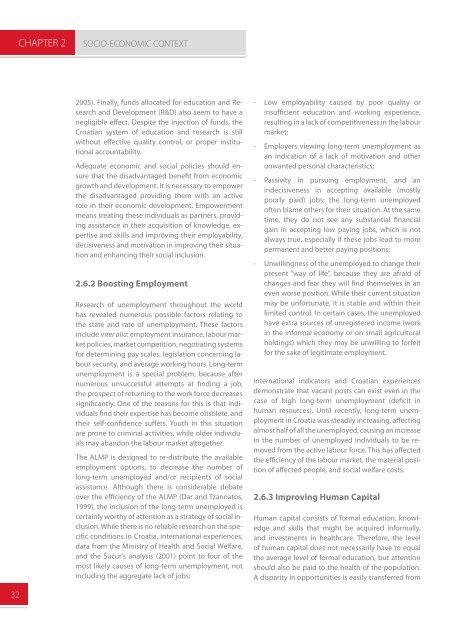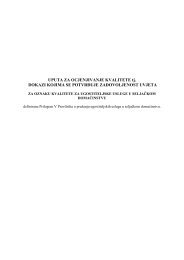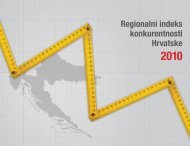WEB engleska verzija end.indd - UNDP Croatia
WEB engleska verzija end.indd - UNDP Croatia
WEB engleska verzija end.indd - UNDP Croatia
- No tags were found...
Create successful ePaper yourself
Turn your PDF publications into a flip-book with our unique Google optimized e-Paper software.
CHAPTER 2SOCIO-ECONOMIC CONTEXT2005). Finally, funds allocated for education and Researchand Development (R&D) also seem to have anegligible effect. Despite the injection of funds, the<strong>Croatia</strong>n system of education and research is stillwithout effective quality control, or proper institutionalaccountability.Adequate economic and social policies should ensurethat the disadvantaged benefit from economicgrowth and development. It is necessary to empowerthe disadvantaged providing them with an activerole in their economic development. Empowermentmeans treating these individuals as partners, providingassistance in their acquisition of knowledge, expertiseand skills and improving their employability,decisiveness and motivation in improving their situationand enhancing their social inclusion.2.6.2 Boosting EmploymentResearch of unemployment throughout the worldhas revealed numerous possible factors relating tothe state and rate of unemployment. These factorsinclude inter alia: employment insurance, labour marketpolicies, market competition, negotiating systemsfor determining pay scales, legislation concerning laboursecurity, and average working hours. Long-termunemployment is a special problem, because afternumerous unsuccessful attempts at finding a job,the prospect of returning to the work force decreasessignificantly. One of the reasons for this is that individualsfind their expertise has become obsolete, andtheir self-confidence suffers. Youth in this situationare prone to criminal activities, while older individualsmay abandon the labour market altogether.The ALMP is designed to re-distribute the availableemployment options, to decrease the number oflong-term unemployed and/or recipients of socialassistance. Although there is considerable debateover the efficiency of the ALMP (Dar and Tzannatos,1999), the inclusion of the long-term unemployed iscertainly worthy of attention as a strategy of social inclusion.While there is no reliable research on the specificconditions in <strong>Croatia</strong>, international experiences,data from the Ministry of Health and Social Welfare,and the Šućur’s analysis (2001) point to four of themost likely causes of long-term unemployment, notincluding the aggregate lack of jobs:- Low employability caused by poor quality orinsufficient education and working experience,resulting in a lack of competitiveness in the labourmarket;- Employers viewing long-term unemployment asan indication of a lack of motivation and otherunwanted personal characteristics;- Passivity in pursuing employment, and anindecisiveness in accepting available (mostlypoorly paid) jobs; the long-term unemployedoften blame others for their situation. At the sametime, they do not see any substantial financialgain in accepting low paying jobs, which is notalways true, especially if these jobs lead to morepermanent and better paying positions;- Unwillingness of the unemployed to change theirpresent “way of life”, because they are afraid ofchanges and fear they will find themselves in aneven worse position. While their current situationmay be unfortunate, it is stable and within theirlimited control. In certain cases, the unemployedhave extra sources of unregistered income (workin the informal economy or on small agriculturalholdings) which they may be unwilling to forfeitfor the sake of legitimate employment.International indicators and <strong>Croatia</strong>n experiencesdemonstrate that vacant posts can exist even in thecase of high long-term unemployment (deficit inhuman resources). Until recently, long-term unemploymentin <strong>Croatia</strong> was steadily increasing, affectingalmost half of all the unemployed, causing an increasein the number of unemployed individuals to be removedfrom the active labour force. This has affectedthe efficiency of the labour market, the material positionof affected people, and social welfare costs.2.6.3 Improving Human CapitalHuman capital consists of formal education, knowledgeand skills that might be acquired informally,and investments in healthcare. Therefore, the levelof human capital does not necessarily have to equalthe average level of formal education, but attentionshould also be paid to the health of the population.A disparity in opportunities is easily transferred from32

















